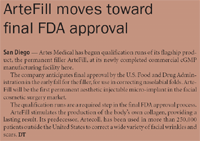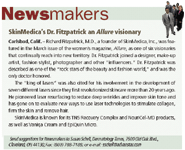- Acne
- Actinic Keratosis
- Aesthetics
- Alopecia
- Atopic Dermatitis
- Buy-and-Bill
- COVID-19
- Case-Based Roundtable
- Chronic Hand Eczema
- Chronic Spontaneous Urticaria
- Drug Watch
- Eczema
- General Dermatology
- Hidradenitis Suppurativa
- Melasma
- NP and PA
- Pediatric Dermatology
- Pigmentary Disorders
- Practice Management
- Precision Medicine and Biologics
- Prurigo Nodularis
- Psoriasis
- Psoriatic Arthritis
- Rare Disease
- Rosacea
- Skin Cancer
- Vitiligo
- Wound Care
Article
Modified growth factors target vascularization
Chicago — Genetically manipulated growth factors could hold the key to producing engineered tissue with vascular systems ready-made for transplantation.

"Our concept is that if we can build three-dimensional capillary networks in vitro - and we have data suggesting that we can - then we can add to those networks other cell types such as cardiomyocytes, arterial smooth muscle cells or other cells to engineer specific tissues" for organ replacement, wound healing and other clinical applications, according to Howard P. Greisler, M.D., professor of surgery and of cell biology, neurobiology and anatomy at Loyola University Medical Center, Chicago.
Collaborative effort Many approaches currently used for engineering tissue of various types basically yield avascularized tissues. Once implanted, these tissues require that one induce vascularization in vivo through means such as inflammatory mechanisms and induction of growth factor expression. Dr. Greisler's approach, however, a collaborative effort with Wilson Burgess, Ph.D., begins with growing a vascularized capillary network in vitro, then adding mesenchymal cells to it.
As a vascular biologist and vascular surgeon, Dr. Greisler has worked extensively with fibroblast growth factor (FGF)-1, particularly within a fibrin delivery system for the purpose of stimulating angiogenic mechanisms to re-endothelialize blood vessels.

"With FGF-1, one of the mutations we've created has had all three of its cysteines removed. That results in a growth factor that is vastly more potent as a mitogen than FGF or any other known mitogen. That's not ideal from the standpoint of the healing of arteries following clinical interventions such as angioplasty or bypass grafting, but it's potentially very useful ... (for) healing cutaneous wounds or closing fascial defects," he says.
Another growth factor that Drs. Greisler and Burgess have constructed is known as the R136K mutation. In this mutation, the arginine at the 136 amino acid position is altered.
"That's the position at which most proteases lose the protein (FGF). In tissue, FGF has a very short biological life span because it degrades quickly. But if you change that one amino acid, it resists degradation and remains active much longer," Dr. Greisler says.
Additional growth factors the researchers have fashioned fuse mutated growth factors with targeting sequences. Heparin binding growth associated molecule (pleiotrophin or HBGAM), for example, interacts with the low-affinity heparan sulfate proteoglycans, which are much more abundant on endothelial cells than on smooth muscle cells or fibroblasts.
"Indirectly, that's a way of targeting the FGF specifically to endothelial cells rather than to all the other cells," he says.
A second chimeric protein, R136K-CBD (collagen binding domain), essentially immobilizes the growth factor to collagen. That's useful from an arterial wound healing standpoint because arterial media contains collagen.
"R136K-CxBD works with collagen-1 and -4, and probably some other subtypes. One can get the growth factor to bind to the collagen and remain in place until the cell that one wants to respond to the growth factor shows up," Dr. Greisler says.
Newsletter
Like what you’re reading? Subscribe to Dermatology Times for weekly updates on therapies, innovations, and real-world practice tips.















